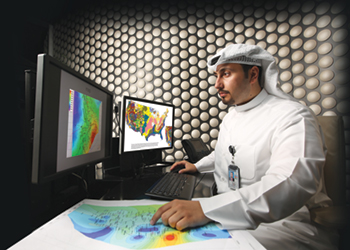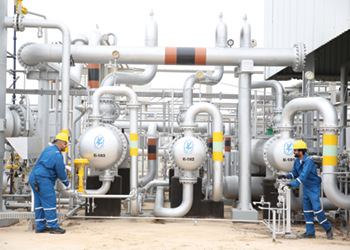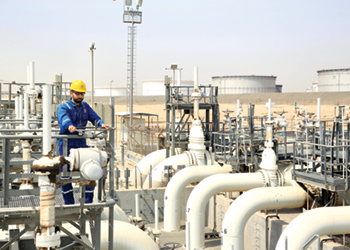
 Kuwait wants to produce 4 million bpd by 2040
Kuwait wants to produce 4 million bpd by 2040
Oil revenues will be critical to Kuwait’s economic progress and that will require substantial upstream investment to achieve robust crude oil and gas production levels as desired by 2040
Kuwait is intensifying efforts to expand its oil and gas resources as the country continues to rely heavily on oil to meet its economic needs.
Major projects underway in both oil and gas will add new capacity, as Kuwait and other Opec members strive to meet growing global demand for energy.
The oil sector remains to be the main driver of Kuwait’s economy and accounts for over half of its GDP, and approximately 90 per cent of government export revenue.
By the end of the last month of the 2021/2022 fiscal, Kuwait was expected to have achieved total oil revenues of about KD16.737 billion ($53.85 billion) during the first 11 months, Arab Times reported.
The price of the Kuwaiti oil barrel during the year averaged $79.86, which is lesser than the budgeted breakeven price of $90 per barrel.
The Gulf state, which is the world’s 10th largest oil producer, is striving to plug its national budgetary deficit. However, with oil prices having steadily risen since Covid-19, there is growing optimism of a breakthrough well in sight.
The 2022-23 budget released early this year shows Kuwait could post its first surplus in nine years at $75 per barrel oil price.
In 2021, Kuwait produced an average production of 2.717 million barrels per day (bpd).
State-owned Kuwait Petroleum Company’s (KPC) announced its plans in 2018 to increase oil production capacity to 4.75 million bpd by 2040. But that was later revised to 3.5 million bpd by 2025 and 4 million bpd by 2040, but analysts say even this maybe an uphill task, says S&P Global.
Last month, KPC said the Gulf state was producing more than 2.8 million barrels per day of oil in accordance with its Opec quota.
Kuwait Oil Company, the largest revenue generating company under the KPC umbrella and responsible for exploration, drilling and production of oil and gas in the country, overcame many challenges to maintain its production figures over the course of 2020-2021 fiscal.
During the period, KOC produced 2.579 million bpd and 541 million standard cu ft per day (mmscfd) of non-associated gas production.
The company drilled 418 new oil and wells, and the number of rigs reached 134. KOC also registered four new Jurassic discoveries over the course.
• Heavy oil: KOC has produced a total of more than 7 million barrels since the start of heavy oil production operations in early 2020. It successfully exported Kuwait’s first shipment of heavy oil, thus enabling the country to diversify its crude oil export products. A total of 18 heavy oil development wells drilled during 2020-21 and 930 wells to date.
Over the medium term, Kuwait is expected to see incremental production of heavy oil from the second phase of the Lower Fars development, set to come online by 2023, adding up to 200,000 b/d by the end of the decade.
The way forward for KOC includes the development of several reservoirs that are difficult and costly to exploit.
Some of the company’s future resources will be derived from Unconventional, enhanced oil recovery (EOR), heavy oil, offshore, and new oil zones.
Kuwait's reliability as a supplier could come from its export of oil products through its investments in the downstream sector such as the 615,000 bpd Al-Zour refinery. The refinery is still in the testing phase, with full capacity expected to be realised by early 2023, SP Global said.
CLEAN FUELS
The Kuwait Integrated Petroleum Industries Company (KIPIC) expects to start exporting refined products from the $16-billion refinery in late October or early November, according a report by MEED magazine.
SP Global said the refinery is expected to reach full capacity by early 2023.
Al-Zour is set to become one of the largest refineries of its kind in the Mena region, and will produce mainly gasoline, diesel and kerosene to Euro 5 emission standards.
Meanwhile, Kuwait exported the first shipment of ultra-low sulfur, low-aromatic gasoline (car fuel) that meets international environmental standards, while boosting the country’s regional and global position in clean energy. Some 35,000 tonnes were shipped.
The cargo was produced thanks to Kuwait National Petroleum Company’s Clean Fuel Project, a major upgrade of Kuwait’s refineries that was commissioned to reduce the sulfur content of fuel products and increase refining capacity.
Kuwait’s Mina Abdullah refinery produced the ULSD in accordance with Euro 6 diesel specifications. The first batch was delivered to a depot in Naples port in Italy.
• Gas: KOC is making every effort to achieve its strategic goal of sustainable non-associated gas production by 2040. KPC had announced plans to increase natural gas production to 4 billion cu ft per day by 2030.
In September, KPC said Kuwait produces 650 mmscfd with plans to increase it to one billion.
Kuwait’s total daily production of associated and non-associated gas during 2020-2021 fiscal year was 1.726 billion scfd, while production of non-associated gas reached 541 mmscfd compared to the previous year’s figure of 490 mmscfd.
This increase was the result of several factors, the most important of which was an improvement related to shut-down procedures at facilities for maintenance operations.
Drilling was also undertaken for non-associated gas at the Jurassic Reservoirs. In 2020-21, KOC drilled 27 deep wells which helped it reach its non-associated gas production targets.
In March, Saudi Arabia and Kuwait agreed to develop the joint Dorra offshore gas field, which can produce 1 billion cu ft of natural and 84,000 barrels of condensate per day. Production will be divided equally between the two sides.
Both countries have also agreed to enable the establishment of Al Khafji joint operations company, which is a joint venture between Kuwait Gulf Oil and Aramco Gulf Operations.
In February, KPC member company, the Kuwait Integrated Petroleum Industries Company (KIPIC) announced the operation of the permanent facilities project to import liquefied natural gas (LNG) at the Al-Zour Complex.
The 225,000-cu-m capacity complex, built in one phase, is said to be the first of its kind locally and the largest in the world in terms of storage capacity.
Reinforcing the production of liquefied gas, the Kuwait National Petroleum Company (KNPC) in March announced the operation of the fifth liquefied gas pipeline at Mina Al-Ahmadi Refinery, which is the company's second most important and productive project after the environmental fuel project.
The new pipeline marks a 30 percent increase in the firm’s production of liquefied gas, as it adds around 805 million sq ft of gas and 106,000 barrels of condensates,
• Petrochemical strategy: Kuwait has updated its petrochemical strategy, which outlines plans to grow annual petrochemical products to 14.5 million tonnes until 2040.
Kuwait aims to deploy advanced technology to grow in the highly profitable but specialised petrochemical industry.
The strategy will see it partner with a global companies to manufacture 15 per cent of the products inside Kuwait by 2040.
Kuwait currently produces nearly 9 million tonnes of petrochemical products annually through the local and global facilities of Kuwait Petrochemical Industries Company (KPIC).
By Abdulaziz Khattak



















































































